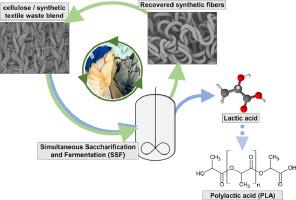Resources, Conservation and Recycling ( IF 11.2 ) Pub Date : 2023-05-26 , DOI: 10.1016/j.resconrec.2023.107060 Sophia Mihalyi , Michelle Tagliavento , Emanuel Boschmeier , Vasiliki-Maria Archodoulaki , Andreas Bartl , Felice Quartinello , Georg M. Guebitz

|
Textile waste is still mostly landfilled or incinerated while a lot of fabrics consist of blended fibers that represent a challenge for recycling. In this study, enzymes were used to specifically decompose cellulose from blends for recovery of synthetic fibers and microbial conversion of resulting glucose into lactic acid (LA) as a building block of the biobased polyester PLA. To overcome enzyme inhibition by glucose and to reduce process cost, simultaneous saccharification and fermentation (SSF) by Weizmannia coagulans in presence of cellulolytic enzymes were investigated. Indeed, viscose fibers in blends were completely hydrolyzed according to weight loss and HPLC quantification of formed glucose which was converted into pure l-LA (25.6 g/L). In parallel, pure synthetic fibers (polyester and polyamide) were recovered as confirmed by SEM, FTIR, and TGA analyses. This approach represents a circular economy concept to recycle and simultaneously valorize each component of a blended textile waste stream.
中文翻译:

Weizmannia coagulans 同时糖化发酵回收合成纤维并从混合纺织废料中生产乳酸
纺织废料仍然主要被填埋或焚烧,而许多织物由混合纤维组成,这对回收提出了挑战。在这项研究中,酶被用来专门分解混合物中的纤维素,以回收合成纤维,并将所得葡萄糖微生物转化为乳酸 (LA),作为生物基聚酯 PLA 的组成部分。为了克服葡萄糖对酶的抑制作用并降低工艺成本,研究了在纤维素分解酶存在下通过凝结魏茨曼藻进行的同步糖化和发酵 (SSF) 。实际上,根据重量损失和转化为纯 l 的形成的葡萄糖的 HPLC 量化,混纺中的粘胶纤维已完全水解-LA(25.6 克/升)。同时,通过 SEM、FTIR 和 TGA 分析证实,回收了纯合成纤维(聚酯和聚酰胺)。这种方法代表了一种循环经济概念,可以回收并同时对混合纺织废料流中的每个成分进行增值。











































 京公网安备 11010802027423号
京公网安备 11010802027423号